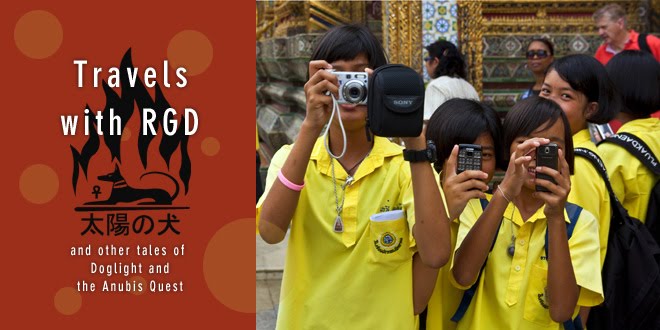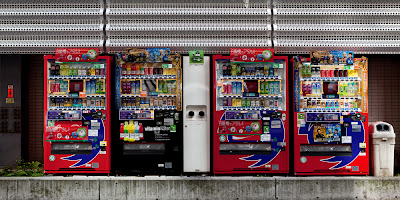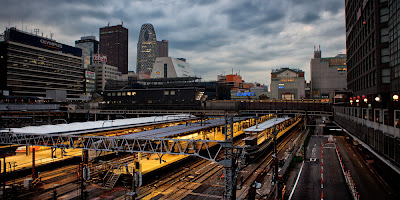(Tip: Click on photos to see a larger version, or go to www.ronalddunlapphotography.com)
All rights reserved.
I welcomed the hot water as it cascaded over my head and down my torso; without a shower in the morning I never feel fully awake. Dressed and loaded for bear, I was out the door by eight.
Down at the desk I got a safety deposit box and put in my passport plus my emergency cash. I also checked my computer in for the day and found that there was a Currency Exchange Machine in the lobby. I changed a hundred and got better rate, 76 yen to the dollar (the extra 3 yen was a moral victory at least).
I had a map to a local Denny's but had difficulty in locating the restaurant. It seems that the city streets are laid out in a very counterintuitive manner, so after plodding around for a while I gave up the notion of having a "Grand Slam."
I was right next to Yoyogi Station, so I availed myself of the opportunity to purchase a Suica card. I have a translation program on my Mac and used it to print out phrases that I thought I might need. In the customer service office I pulled out the "I want to buy a Suica Card" sheet and showed it to the JR representative. He smiled, nodded and asked for ¥2000 (about $26.32). I asked (or more accurately pantomimed) that I wanted to add additional money to the card, but he shook his head and pointed out into the station proper, where I could use one of the machines to add to my card up to 18,000 yen ($231).
Travel Tip: I highly recommend the Suica card. Very similar to Hong Kong's Octopus Card, it's a prepaid travel pass that makes using the trains and metro system a breeze. Just swipe the card and you're on your way, no need to spend time trying to figure out which ticket to buy. It's really a time saver and alleviates a lot of stress, plus you don't need exact change.
Travel Tip: Shinjuku Station is the busiest train station in the world, with an average of over 3.5 million people passing through it each day. It can be very complex and confusing. I found that by using Yoyogi Station, just a few block to the south, you save a lot of time and don't have to deal with the ebb and flow of the massive crowds.
According to the internet there are more than a thousand McDonald's franchises in the greater Tokyo area, and I think that might be correct because there seems to be one on every block. After I had gotten my Suica Card, I walked across the street and got a sausage sandwich. Unfortunately I pointed to the wrong picture and got a bacon, egg and cheese McGriddle and a small Coke (and when they say small they're not kidding). I found the McGriddle part of the sandwich was not to my liking.
After I finished breakfast I consulted my pocket map and began to trek over to the skyscraper section of Shinjuku. I was looking for Bic Camera and the Tokyo Metropolitan Government Building. My itinerary called for me to hit the camera store first, but halfway there I found signs directing me to the Metropolitan Building. I hung a left and walked five or six more blocks to the east. The "Observation Deck," on the 45th floor, is free, but there's always a line. It takes a while to get your turn to be squeezed into the elevator with 10 or 12 other individuals and be whisked up, to get your opportunity to observe.
It was a clear but somewhat hazy morning. This observatory is great place to see the city from above, but not the best place to photograph it. There are massive reflections everywhere, and the best views (of Tokyo Tower and downtown) are usurped by a restaurant. You need to be a patron if you want to photograph in that direction.
The day views were just so-so, and I decided that I'd do better if I came at night. As I was standing in line for the descending elevator ride, I noticed that they had a souvenir stamp that you could use to denote your visit. I availed myself of the opportunity by annotating my journal.
Once down, I walked back the way I came. It was a bit cooler than I would have preferred, especially in this section of the city. Skyscrapers always disrupt the normal air currents, creating wind-tunnel effects that can chill you to the bone, even on warm days.
At Bic Camera, they have a special counter for English-speaking customers. I told the representative that I was looking for a Fugifilm Finepix X100, and he found it for me immediately. The only problem was that it was $400 more than I could purchase it for in the U.S. All the cameras there were more expensive, by about 30%, than you can get them for at home. What a disappointment! I took the rep's card and headed back to my hotel.
I had an appointment with Tatsumi Orimoto at 1 p.m. I'd first met Tatsumi in the early 1970s at Chouinard's Art Institute. We were there the last year it was open; the next year, I headed to California Institute of the Arts and he'd headed to New York City. I was sitting in the lobby when he arrived at 1:30, late as usual. We hadn't seen each other for over 20 years but there was instant recognition when he came through the doors. We left looking for a cheap place to eat.
There seems to be a one restaurant for every single person in Tokyo. They are everywhere. One out of every three ground-floor establishments seems to be either a snacking, dining or drinking concern. I can't see how there is a large-enough customer base to keep them all afloat.
He wanted to show me around Kabukicho, which is Tokyo's red-light district and all-around place for "company men" to relax. It's also the place for unwary "gaijins" (foreigners) to get ripped off. It is supposedly run by some very tough Japanese, Korean and Chinese gangsters. As you enter the district, there are audio warnings playing, from the local merchant association, letting you know that visitors must beware (i.e., settle on a price before sitting down or you could end up paying a lot more than you than you think is fair).
Tatsumi is an internationally recognized performance artist, especially in Europe. He spent a lot of time there drinking ale, and that has contributed to him coming down with gout. Last month, he told me, it was so bad he had to use a wheelchair to get around. He was better now, but still couldn't walk for long distances without resting every now and then. We spent a couple of hours in Kabukicho with him pointing out the sex shops (whose signs appear innocuous to westerners, who are unfamiliar with Japanese fetish vernacular) and the dark-suited Yakuza who directed their operations. I kept trying to photograph people but they were uncooperative, and Tatsumi advised me not to push it.
We had a late-afternoon snack at KFC and then walked back to Shinjuku Station, where we agreed that I'd meet him on Wednesday in front of the statue of Hachiko (faithful dog) in Shibuya Station. From there we'd go to his home in Kawasaki City to have dinner with "Mama." He disappeared into the bowels of the station after giving me instructions on how to get back to my hotel. And to my surprise, after following them, I found the hotel in the same place I'd left it. Once assured of its location, I then turned around and continued to explore for another few hours.




























































